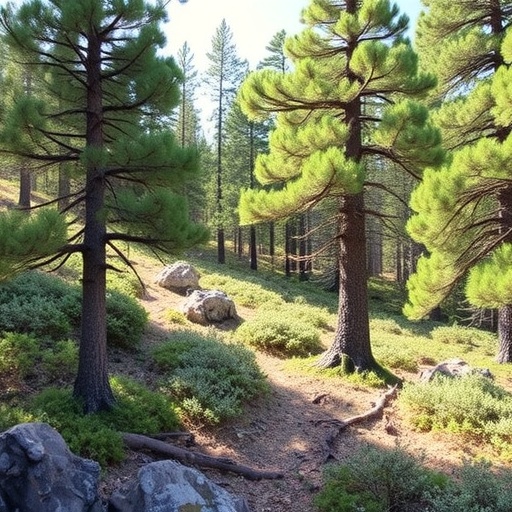Recent research into carbon stock dynamics within juniper woodlands has illuminated the complex interplay between socio-ecological and environmental variables. Conducted in the monsoon-shadow zone of the eastern Hindu Kush, this study sheds light on critical factors that influence carbon storage in these unique ecosystems. The findings present significant implications for climate change mitigation strategies, particularly in areas that are increasingly vulnerable to shifting climatic conditions.
Juniper forests, known for their resilience and adaptability, play a pivotal role in carbon sequestration. However, their capacity to store carbon effectively hinges on multiple factors, including local socio-economic conditions and ecological parameters. The study by Din and Khan explores these intricate relationships, providing a comprehensive overview of how different elements contribute to carbon dynamics in these woodlands.
Understanding the socio-ecological context is essential. Human activities, land-use changes, and agricultural practices can profoundly impact juniper ecosystems. For instance, overgrazing and deforestation, driven by local economic needs, can significantly reduce the carbon stock potential of these woodlands. The authors emphasize the need to integrate socio-economic factors into conservation strategies to enhance carbon sequestration capabilities.
On the environmental front, variables such as rainfall patterns, temperature fluctuations, and soil moisture content play a crucial role. The eastern Hindu Kush region’s unique climatic conditions, particularly during the monsoon season, significantly affect juniper forest health and carbon storage. These environmental dynamics serve not only as a foundation for understanding the local ecosystem but also provide a framework for developing effective climate action strategies.
The study reveals that the resilience of juniper woodlands relies heavily on their ability to adapt to changing environmental conditions. With climate change posing unprecedented challenges, the potential for these ecosystems to continue functioning as carbon sinks is at risk. Therefore, a nuanced understanding of both human influence and environmental dynamics becomes critical in safeguarding these vital resources.
Another critical aspect highlighted in the research is the role of community involvement in the management of juniper woodlands. Engaging local communities in conservation efforts can enhance the effectiveness of carbon sequestration initiatives. The authors advocate for policies that recognize and incorporate indigenous knowledge and practices, which have historically contributed to the sustainability of these forested areas.
The findings of this research not only provide a scientific basis for understanding carbon dynamics but also highlight the urgent need for interdisciplinary approaches in environmental management. By marrying ecological research with socio-economic insights, conservation strategies can be more effectively tailored to mitigate climate impacts while addressing local community needs and aspirations.
The paper’s implications extend beyond the eastern Hindu Kush. The challenges faced by these juniper woodlands echo in similar ecosystems worldwide. As climate change continues to affect global weather patterns and biodiversity, understanding local carbon dynamics becomes a key aspect of broader climate action frameworks.
Furthermore, as nations strive to meet international climate targets, the role of forests in carbon storage is being reevaluated. Juniper woodlands, with their unique characteristics and significant carbon sequestration potential, necessitate focused research and conservation efforts. The insights gained from this study could inform global strategies aimed at enhancing forest carbon stocks.
Incorporating findings such as those presented by Din and Khan into policy-making can lead to more effective and sustainable environmental management practices. As the growing body of research underscores the link between forest health, climate resilience, and carbon dynamics, stakeholders, including governments, conservation organizations, and local communities, must collaborate.
Promoting awareness about the importance of juniper woodlands and their ecological functions is vital. Public education campaigns can foster a greater appreciation for these ecosystems and encourage community stewardship. By empowering local populations to take action toward preserving these resources, long-term conservation goals can be achieved.
Ultimately, millennia-old ecosystems such as juniper woodlands must be integrated into contemporary climate strategies. By understanding and leveraging their carbon storage potential, communities can play a vital role in global efforts to combat climate change. This research not only provides a pathway to better conservation practices but also serves as a call to action for stakeholders at all levels.
In conclusion, the intricate dynamics between socio-ecological factors and the environmental context of juniper woodlands reveal the multitude of influences on carbon stock levels. The ongoing research highlighted by Din and Khan lays the groundwork for future studies and conservation initiatives aimed at combating the escalating challenges posed by climate change. Our understanding of these ecosystems’ roles in global carbon cycles will be essential in developing effective mitigation strategies moving forward.
Subject of Research: Carbon stock dynamics in juniper woodlands
Article Title: Carbon stock dynamics in juniper woodlands are jointly influenced by socio-ecological and environmental variables in the monsoon-shadow zone of the eastern Hindu Kush: insights for climate change mitigation strategies.
Article References: Din, N.U., Khan, N. Carbon stock dynamics in juniper woodlands are jointly influenced by socio-ecological and environmental variables in the monsoon-shadow zone of the eastern Hindu Kush: insights for climate change mitigation strategies. Environ Monit Assess 197, 1364 (2025). https://doi.org/10.1007/s10661-025-14787-9
Image Credits: AI Generated
DOI: https://doi.org/10.1007/s10661-025-14787-9
Keywords: Carbon dynamics, juniper woodlands, climate change, socio-ecological factors, environmental variables, sustainability, conservation strategies.




